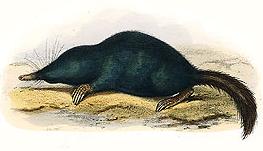
Orthohantavirus is a genus of single-stranded, enveloped, negative-sense RNA viruses in the family Hantaviridae within the order Bunyavirales. Members of this genus may be called orthohantaviruses or simply hantaviruses.

Sin Nombre orthohantavirus (SNV) is the prototypical etiologic agent of hantavirus cardiopulmonary syndrome (HCPS).

Bunyavirales is an order of segmented negative-strand RNA viruses with mainly tripartite genomes. Member viruses infect arthropods, plants, protozoans, and vertebrates. It is the only order in the class Ellioviricetes. The name Bunyavirales derives from Bunyamwera, where the original type species Bunyamwera orthobunyavirus was first discovered. Ellioviricetes is named in honor of late virologist Richard M. Elliott for his early work on bunyaviruses.
Seoul orthohantavirus (SEOV) is a member of the Orthohantavirus family of rodent-borne viruses and is one of the 4 hantaviruses that are known to be able to cause Hantavirus hemorrhagic fever with renal syndrome (HFRS). It is an Old World hantavirus; a negative sense, single-stranded, tri-segmented RNA virus.

Andes orthohantavirus (ANDV), a species of Orthohantavirus, is a major causative agent of hantavirus cardiopulmonary syndrome (HCPS) and hantavirus pulmonary syndrome (HPS) in South America. It is named for the Andes mountains of Chile and Argentina, where it was first discovered. Originating in the reservoir of rodents, Andes orthohantavirus is easily transmitted to humans who come into contact with infected rodents or their fecal droppings. However, infected rodents do not appear ill, so there is no readily apparent indicator to determine whether the rodent is infected or not. Additionally, Andes orthohantavirus, specifically, is the only hantavirus that can be spread by human to human contact via bodily fluids or long-term contact from one infected individual to a healthy person.

Urotrichini is a tribe of the mole family, and consists of Japanese and American shrew-moles. They belong to the Old World moles and relatives branch of the mole family (Talpidae). There are only two species, each of which represents its own genus. The name "shrew-moles" refers to their morphological resemblance to shrews, while generally being thought of as "true moles". The species are the Japanese shrew mole, True's shrew mole and American shrew mole.
Playa de Oro virus (OROV) is a probable species of orthohantavirus found in the rodents Oryzomys couesi and Sigmodon mascotensis in the Mexican state of Colima. The former is thought to be the main host. The sequences of parts of the virus's RNA-based genome have been determined; they differ by 7–10% in amino acid composition and 22–24% in nucleotide composition from closely related viruses.
Sangassou orthohantavirus(SANGV) is single-stranded, negative-sense RNA virus species of the genus Orthohantavirus in the Bunyavirales order. It was first isolated in an African wood mouse in the forest in Guinea, West Africa in 2010. It is named for the village near where the mouse was trapped. It is the first indigenous Murinae-associated African hantavirus to be discovered.
Muju virus(MUV) is a zoonotic negative-sense single-stranded RNA virus of the genus Orthohantavirus. It is a member virus of Puumala orthohantavirus. It is one of four rodent-borne Hantaviruses found in the Republic of Korea. It is the etiologic agent for Hantavirus hemorrhagic fever with renal syndrome (HFRS). The other species responsible for HFRS in Korea are Seoul orthohantavirus, Hantaan orthohantavirus, and Soochong virus.
Magboi virus (MGBV) is a novel, bat-borne Orthohantavirus discovered in a slit-faced bat trapped near the Magboi Stream in eastern Sierra Leone in 2011. It is a single-stranded, negative sense, RNA virus in the Bunyavirales order.
Monongahela virus (MGLV) is a single-stranded, negative-sense Orthohantavirus virus of zoonotic origin that causes hantavirus pulmonary syndrome.
Limestone Canyon virus (LSC) is a single-stranded, negative-sense RNA zoonotic Orthohantavirus that is genetically similar to Sin Nombre orthohantavirus which causes Hantavirus pulmonary syndrome (HPS) in humans. HPS causing hantaviruses are found only in the United States and South America.
Thottopalayam thottimvirus, formerly Thottapalayam virus, (TMPV) is single-stranded, enveloped, negative-sense RNA virus species of the genus Thottimvirus in the Bunyavirales order. It is the first hantavirus to be isolated from a shrew. It was discovered in India in 1964.
Topografov virus is an enveloped, negative-sense RNA virus of the genus Orthohantavirus in the Bunyavirales order. It is the first hantavirus to be isolated from Siberian lemmings found near the Topografov River in the Taymyr Peninsula, Siberia.
Imjin thottimvirus(MJNV) is a single-stranded, enveloped, negative-sense RNA virus of the orthohantavirus genus in the Bunyavirales order. It is a newly identified hantavirus isolated from the lung tissues of Ussuri white-toothed shrews of the species Crocidura lasiura captured near the demilitarized zone in the Republic of Korea during 2004 and 2005.
Khabarovsk virus(KBR) is a orthohantavirus in the Bunyavirales order isolated from Microtus fortis discovered in far-east Russia. It is an enveloped, negative-sense RNA virus.
Nova virus is a single-stranded, negative-sense, enveloped RNA virus with a trisegmented genome. It is one of the most divergent lineages of the hantavirus group – zoonotic viruses of the family Bunyaviridae. No known human cases of infection have yet been reported
Rockport virus (RKPV) is a single-stranded, enveloped, negative-sense RNA orthohantavirus.
Oxbow virus(OXBV) is a single-stranded, enveloped, negative-sense RNA orthohantavirus.
Thailand virus (THAIV) is a single-stranded, enveloped, negative-sense RNA orthohantavirus.



